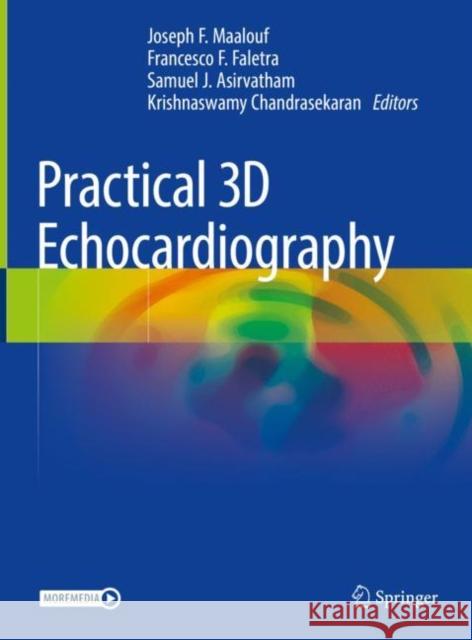Practical 3D Echocardiography » książka



Practical 3D Echocardiography
ISBN-13: 9783030729400 / Angielski / Twarda / 2021 / 450 str.
Practical 3D Echocardiography
ISBN-13: 9783030729400 / Angielski / Twarda / 2021 / 450 str.
(netto: 651,74 VAT: 5%)
Najniższa cena z 30 dni: 655,41
ok. 22 dni roboczych
Bez gwarancji dostawy przed świętami
Darmowa dostawa!
Preface
Part I. Basic, practical principles of 3D Echocardiography
Chapter 1: Imaging principles and acquisition modes
Chapter 2: Image optimization tools and image display
Chapter 3: 3DE Color Doppler acquisition and optimization and 3DE artifacts, caveats, and pitfalls
Chapter 4: 3DE Knobology: A practical guide to use of the available vendor platforms
Part II. Native and Prosthetic Heart Valves
Chapter 5: 3DE of Normal mitral valve: Image display and anatomic correlations
Chapter 6: 3DE Spectrum of mitral valve prolapse
Chapter 7: Rheumatic mitral valve diseases and mitral annular calcification: Role of 3DE
Chapter 8: Role of 3DE in assessment of functional mitral regurgitation
Chapter 9: Incremental value of 3DE over 2DE in assessment of mitral clefts and other congenital mitral valve diseasesChapter 10: 3D color flow Doppler assessment of mitral regurgitation: Advantages over 2D color Doppler
Chapter 11: 3DE anatomy of normal aortic valve and root. Image display and anatomic correlations
Chapter 12: 3DE of the spectrum of native aortic valve and subvalvular diseases and pathological correlationsChapter 13: Correlation of 3DE with CT and MRI in the diagnosis and assessment of valvular heart disease and new trends
Chapter 14: 3DE appearance of the different types of normal mechanical and biological valves
Chapter 15: 3DE assessment of the pathological spectrum of mitral prosthesis and sewing ring dysfunction: Incremental value over 2DEChapter 16: 3DE assessment of pathological spectrum of aortic prosthesis dysfunction: Incremental value over 2DE
Chapter 17: Native and Prosthetic Valve Endocarditis: Incremental value of 3DE over 2DE
Chapter 18: CT and MRI correlations with 3DE in assessment of prosthetic valves including new trendsPart III. Atria and Atrial Septum
Chapter 19: Normal 3DE anatomy of atrial septum: Image display and anatomical specimen correlationsChapter 20: Atrial septal defects: 2DE vs 3DE and anatomic specimen
Chapter 21: CT and MRI correlations of atria and atrial septum
Part IV. Ventricles and Ventricular Septum
Chapter 22: How to acquire and calculate 3D LV and RV volumes and ejection fraction (three vendors)
Chapter 23: Is 3D better than 2D during stress echo?Chapter 24: Congenital and acquired ventricular septal defects
Chapter 25: CT and MRI of ventricles and ventricular septum
Part V. Cardiac Masses
Chapter 26: Role of 3DE in assessment of cardiac masses: incremental value over 2DE
Part VI. Role of 3DE in catheter-based structural heart disease interventions
Chapter 27: Atrial Interventions
Chapter 28: Ventricular interventions
Chapter 29: Edge-to-Edge mitral valve repair
Chapter 30: Periprosthetic leak repairChapter 31: Valve-in-valve/ring implantation
Part VII. Role of 3DE in catheter –based electrophysiologic procedures
Chapter 32: The role of imaging techniques in electrophysiologic proceduresChapter 33: The Role of CT and MRI in electrophysiologic procedures
Part VII. New Trends for 3DE in catheter-based Interventions
Chapter 34: Novel percutaneous techniques for mitral and tricuspid valve repair
Chapter 35: Echo-navigation
Chapter 36: Evolving role of 3D printing in guiding interventional procedures
Joseph F. Maalouf, M.D., is Professor of Medicine at Mayo Clinic College of Medicine, Cardiovascular Diseases Consultant, and Director of Interventional Echocardiography Department of Cardiovascular Medicine at Mayo Clinic in Rochester, Minnesota. Dr. Maalouf graduated in 1975 from the American University of Beirut-Lebanon where he also did two years of Internal Medicine Residency training. He completed three years of Fellowship training in Cardiovascular Medicine including one year of Fellowship training in echocardiography at Columbia University/St-Luke’s hospital and Mount Sinai hospital in New York City.
Francesco F. Faletra, M.D., is Head of Cardiac Imaging Department at Cardiocentro Ticino in Lugano, Switzerland since 2005. His focus is on 3D TEE and he regularly takes classes on this topic at cardiologists coming from all Europe. During his career, he has been the author of several books, chapters and peer reviews papers.
Samuel J. Asirvatham, M.D., is an electrophysiologist at Mayo Clinic's campus in Rochester, Minnesota. After completing medical school at the Christian Medical College in Vellore, India, his internship was at the Columbia University Medical Center in New York City. Dr. Asirvatham is currently a professor of medicine in the Division of Cardiovascular Diseases within the Department of Internal Medicine and a professor of pediatrics in the Division of Pediatric Cardiology within the Department of Pediatric and Adolescent Medicine. He is a consultant in cardiac electrophysiology, program director for the Clinical Cardiac Electrophysiology Fellowship and director of strategic collaboration for the Center for Innovation at Mayo Clinic, Rochester, Minnesota.
Krishnaswamy Chandrasekaran, Dr. K. Chandrasekaran, commonly known as Dr.Chandra, is a Professor of Medicine, Mayo Clinic College of Medicine, Emeritus Consultant, Cardiovascular Diseases, Department of Cardiovascular Medicine at the Mayo Clinic in Rochester, Minnesota. Dr.Chandra graduated from Madras Medical College, Madras University, Chennai, Tamil Nadu, India 1974. His further training in internal medicine and cardiology was from New York Medical College and the University of Oklahoma. He was instrumental in creating Interventional echocardiography at Mayo Clinic. He spends part of his time teaching and training echocardiography in India.
This extensive clinically focused book is a detailed practical 3D echocardiography imaging reference that addresses the concerns and needs of both the novice and experienced 3D echocardiographer. Chapters have been written in a highly instructive and practical disease- and problem-oriented approach supported by illustrative high-quality images (and corresponding 3D echo video clips where applicable) that demonstrate the incremental value of 3D echocardiography over 2D echocardiography in practice.
Practical 3D Echocardiography is an intuitive guide to 3D imaging – what to look for, how to look for it, the best and special views, caveats and pitfalls when applicable, and clinical pearls and pointers – that can be used in daily practice. It is therefore of immense value to any practicing or trainee echocardiographer, cardiologist and internist.
1997-2025 DolnySlask.com Agencja Internetowa
KrainaKsiazek.PL - Księgarnia Internetowa









